Holmes Institute HI6007 Statistics for Business Decisions
VerifiedAdded on 2023/06/07
|12
|1603
|290
Homework Assignment
AI Summary
This assignment solution covers key statistical concepts for business decisions, including frequency distributions, regression analysis, and ANOVA. It addresses questions related to examination score analysis, regression model interpretation, and hypothesis testing for comparing different programs within a corporation. The solution includes detailed tables generated in MS Excel, interpretations of statistical outputs, and recommendations based on the analysis. Topics such as cumulative frequency, relative frequency, percentage distribution, correlation coefficients, and significance levels are thoroughly explored. The regression analysis focuses on the relationship between supply and unit price, as well as the impact of competitor pricing on sales. Desklib provides comprehensive resources, including solved assignments and past papers, to support students in mastering these statistical techniques.
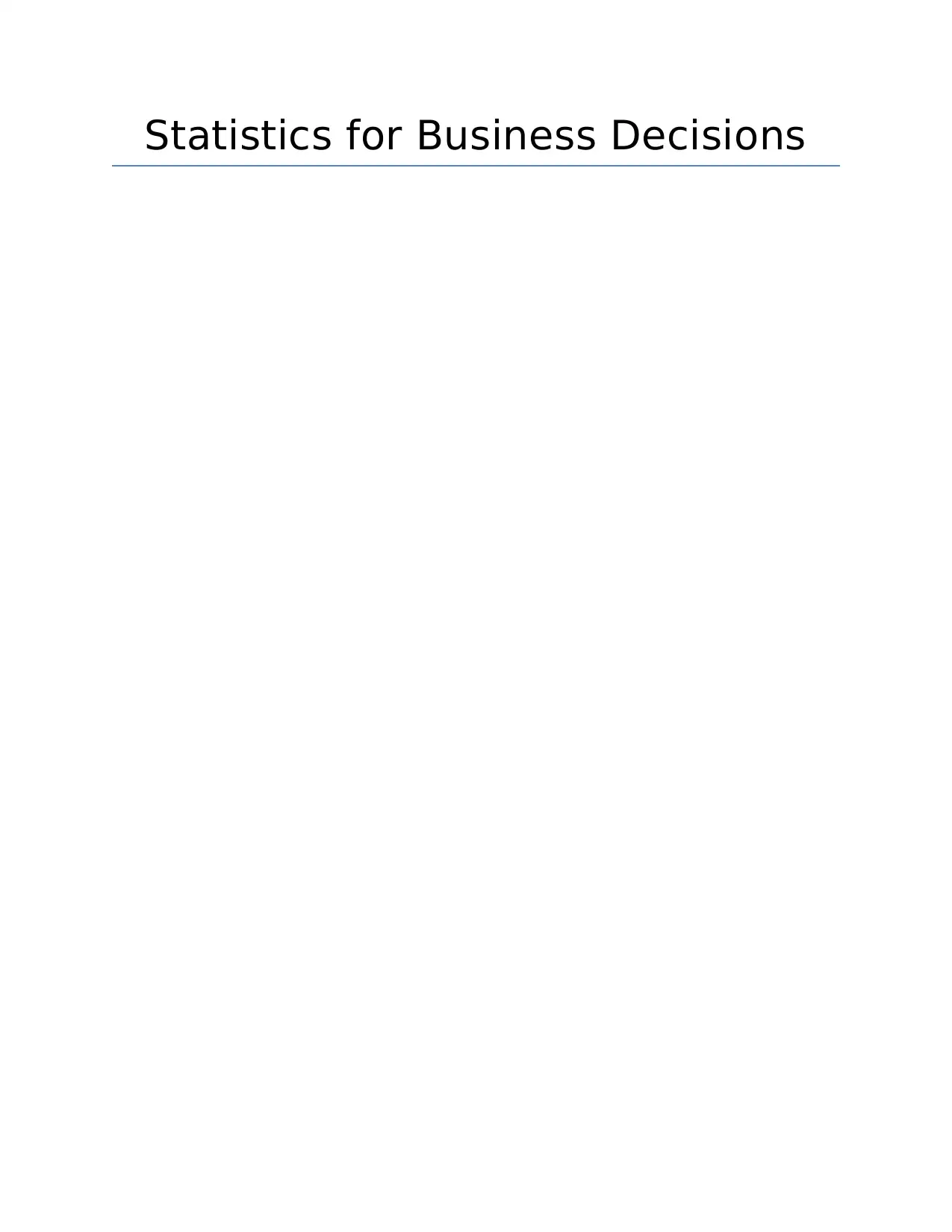
Statistics for Business Decisions
Paraphrase This Document
Need a fresh take? Get an instant paraphrase of this document with our AI Paraphraser
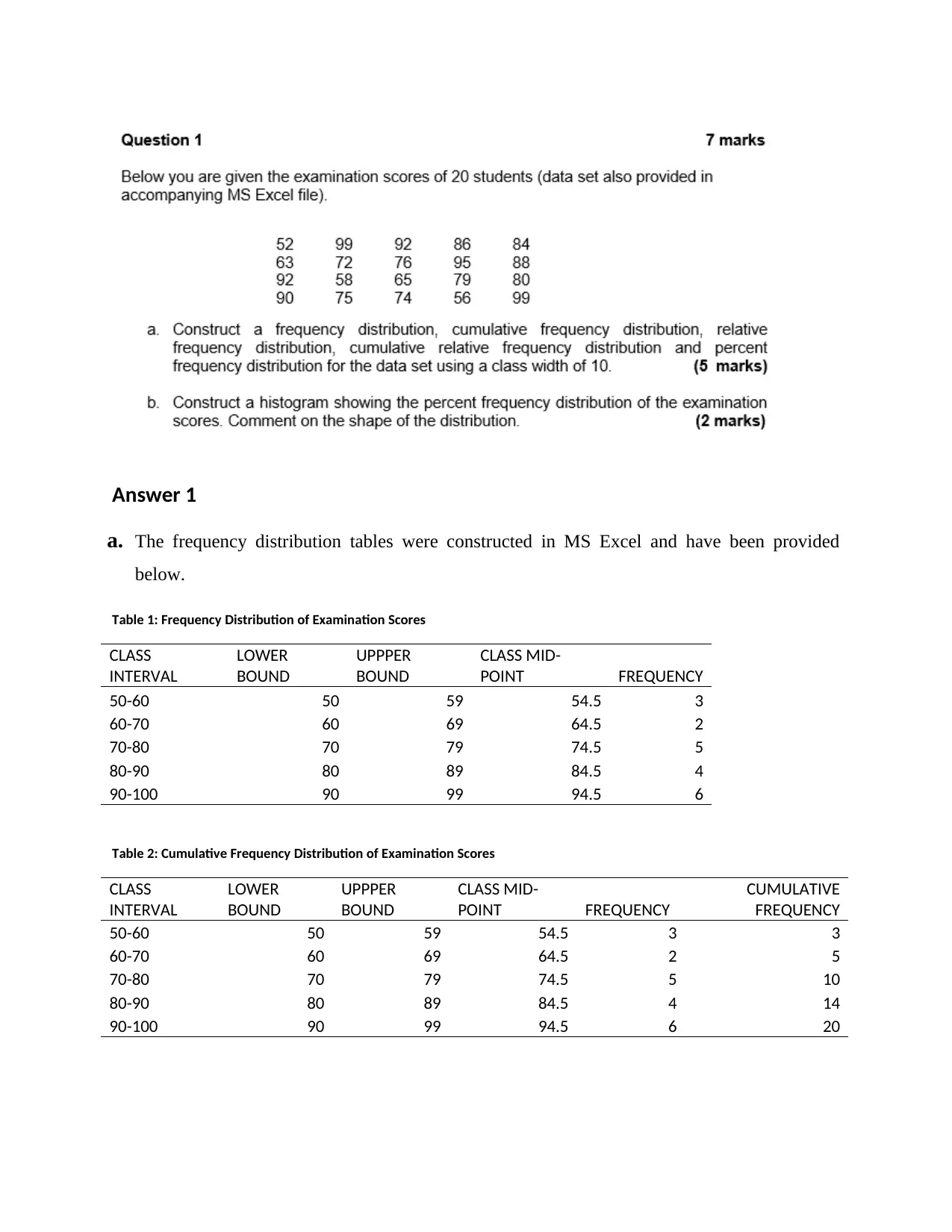
Answer 1
a. The frequency distribution tables were constructed in MS Excel and have been provided
below.
Table 1: Frequency Distribution of Examination Scores
CLASS
INTERVAL
LOWER
BOUND
UPPPER
BOUND
CLASS MID-
POINT FREQUENCY
50-60 50 59 54.5 3
60-70 60 69 64.5 2
70-80 70 79 74.5 5
80-90 80 89 84.5 4
90-100 90 99 94.5 6
Table 2: Cumulative Frequency Distribution of Examination Scores
CLASS
INTERVAL
LOWER
BOUND
UPPPER
BOUND
CLASS MID-
POINT FREQUENCY
CUMULATIVE
FREQUENCY
50-60 50 59 54.5 3 3
60-70 60 69 64.5 2 5
70-80 70 79 74.5 5 10
80-90 80 89 84.5 4 14
90-100 90 99 94.5 6 20
a. The frequency distribution tables were constructed in MS Excel and have been provided
below.
Table 1: Frequency Distribution of Examination Scores
CLASS
INTERVAL
LOWER
BOUND
UPPPER
BOUND
CLASS MID-
POINT FREQUENCY
50-60 50 59 54.5 3
60-70 60 69 64.5 2
70-80 70 79 74.5 5
80-90 80 89 84.5 4
90-100 90 99 94.5 6
Table 2: Cumulative Frequency Distribution of Examination Scores
CLASS
INTERVAL
LOWER
BOUND
UPPPER
BOUND
CLASS MID-
POINT FREQUENCY
CUMULATIVE
FREQUENCY
50-60 50 59 54.5 3 3
60-70 60 69 64.5 2 5
70-80 70 79 74.5 5 10
80-90 80 89 84.5 4 14
90-100 90 99 94.5 6 20
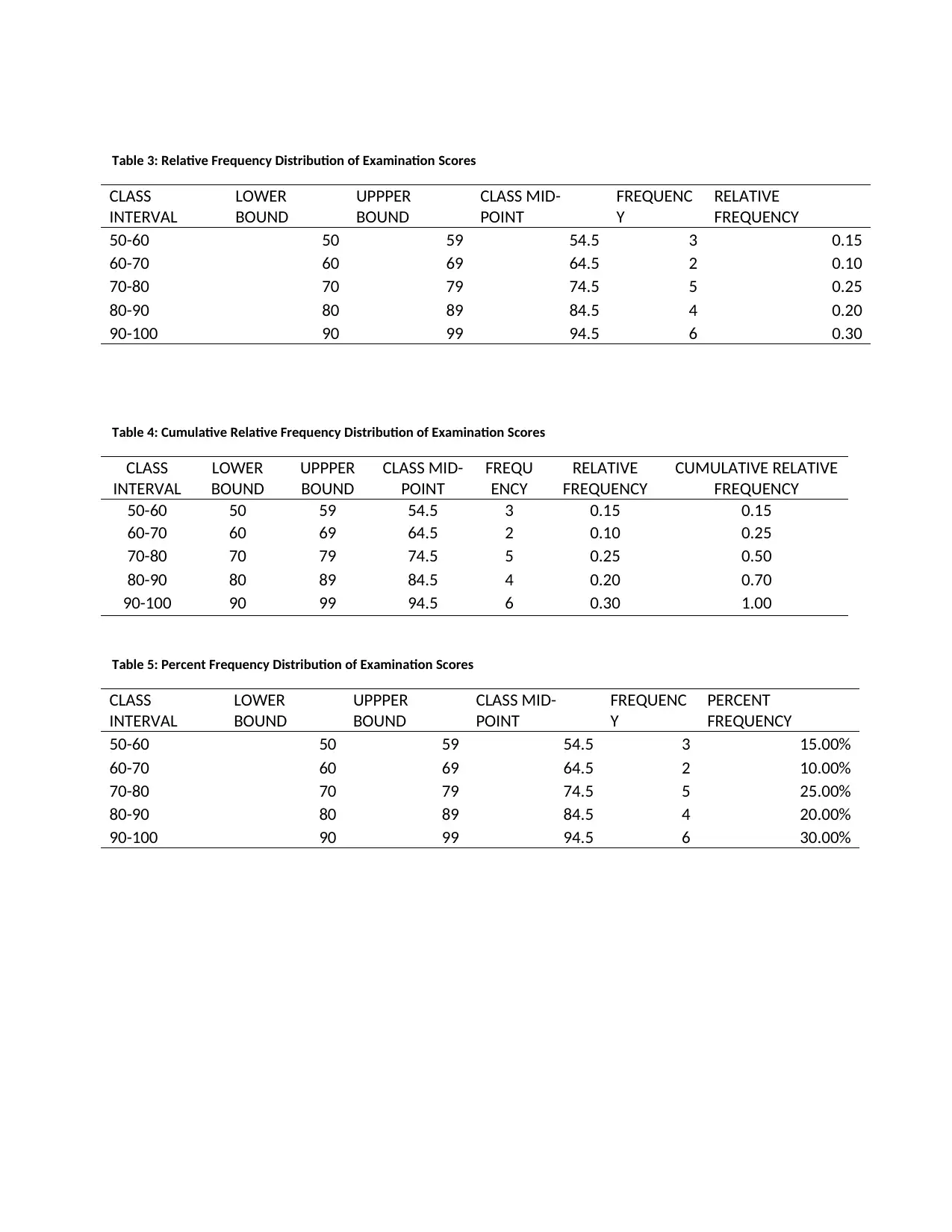
Table 3: Relative Frequency Distribution of Examination Scores
CLASS
INTERVAL
LOWER
BOUND
UPPPER
BOUND
CLASS MID-
POINT
FREQUENC
Y
RELATIVE
FREQUENCY
50-60 50 59 54.5 3 0.15
60-70 60 69 64.5 2 0.10
70-80 70 79 74.5 5 0.25
80-90 80 89 84.5 4 0.20
90-100 90 99 94.5 6 0.30
Table 4: Cumulative Relative Frequency Distribution of Examination Scores
CLASS
INTERVAL
LOWER
BOUND
UPPPER
BOUND
CLASS MID-
POINT
FREQU
ENCY
RELATIVE
FREQUENCY
CUMULATIVE RELATIVE
FREQUENCY
50-60 50 59 54.5 3 0.15 0.15
60-70 60 69 64.5 2 0.10 0.25
70-80 70 79 74.5 5 0.25 0.50
80-90 80 89 84.5 4 0.20 0.70
90-100 90 99 94.5 6 0.30 1.00
Table 5: Percent Frequency Distribution of Examination Scores
CLASS
INTERVAL
LOWER
BOUND
UPPPER
BOUND
CLASS MID-
POINT
FREQUENC
Y
PERCENT
FREQUENCY
50-60 50 59 54.5 3 15.00%
60-70 60 69 64.5 2 10.00%
70-80 70 79 74.5 5 25.00%
80-90 80 89 84.5 4 20.00%
90-100 90 99 94.5 6 30.00%
CLASS
INTERVAL
LOWER
BOUND
UPPPER
BOUND
CLASS MID-
POINT
FREQUENC
Y
RELATIVE
FREQUENCY
50-60 50 59 54.5 3 0.15
60-70 60 69 64.5 2 0.10
70-80 70 79 74.5 5 0.25
80-90 80 89 84.5 4 0.20
90-100 90 99 94.5 6 0.30
Table 4: Cumulative Relative Frequency Distribution of Examination Scores
CLASS
INTERVAL
LOWER
BOUND
UPPPER
BOUND
CLASS MID-
POINT
FREQU
ENCY
RELATIVE
FREQUENCY
CUMULATIVE RELATIVE
FREQUENCY
50-60 50 59 54.5 3 0.15 0.15
60-70 60 69 64.5 2 0.10 0.25
70-80 70 79 74.5 5 0.25 0.50
80-90 80 89 84.5 4 0.20 0.70
90-100 90 99 94.5 6 0.30 1.00
Table 5: Percent Frequency Distribution of Examination Scores
CLASS
INTERVAL
LOWER
BOUND
UPPPER
BOUND
CLASS MID-
POINT
FREQUENC
Y
PERCENT
FREQUENCY
50-60 50 59 54.5 3 15.00%
60-70 60 69 64.5 2 10.00%
70-80 70 79 74.5 5 25.00%
80-90 80 89 84.5 4 20.00%
90-100 90 99 94.5 6 30.00%
⊘ This is a preview!⊘
Do you want full access?
Subscribe today to unlock all pages.

Trusted by 1+ million students worldwide
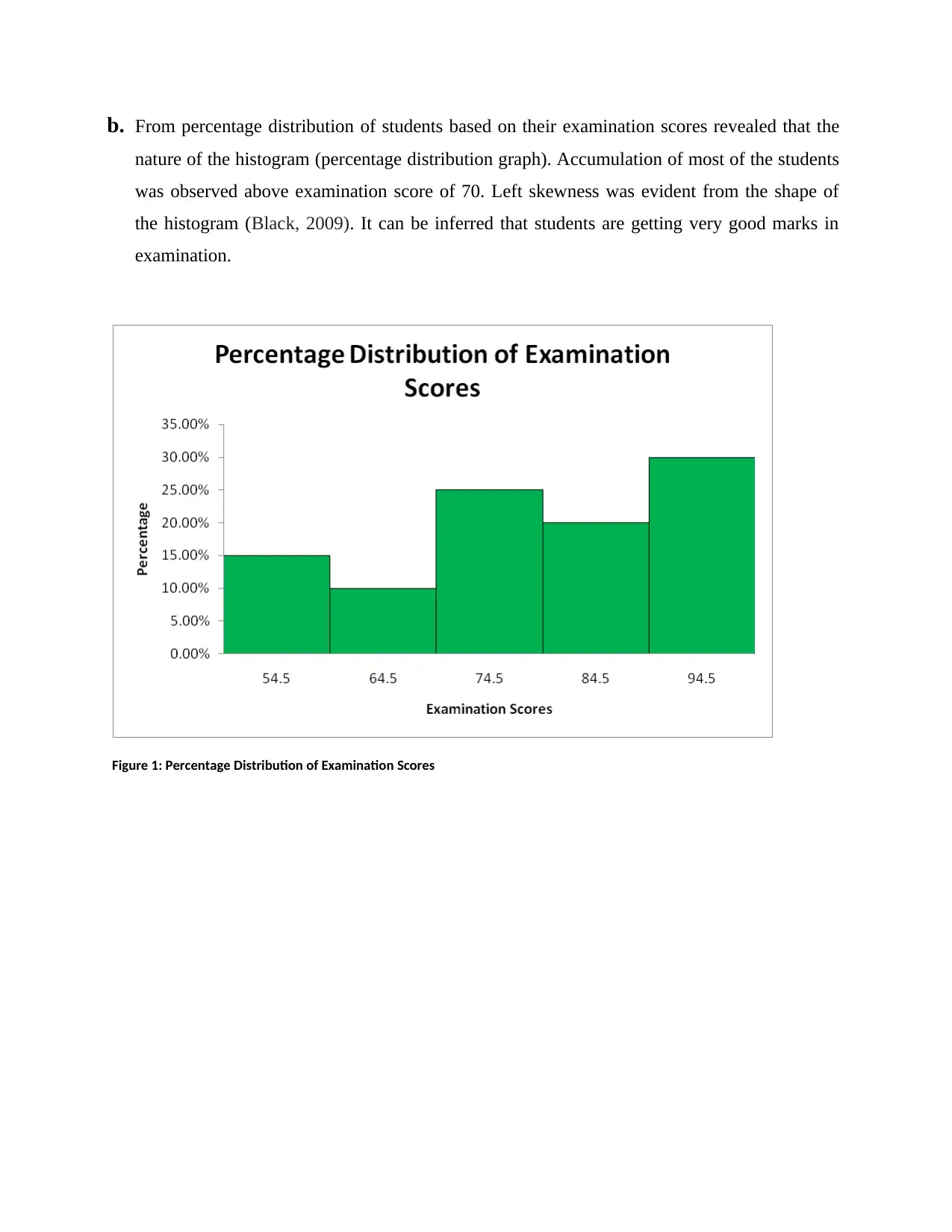
b. From percentage distribution of students based on their examination scores revealed that the
nature of the histogram (percentage distribution graph). Accumulation of most of the students
was observed above examination score of 70. Left skewness was evident from the shape of
the histogram (Black, 2009). It can be inferred that students are getting very good marks in
examination.
Figure 1: Percentage Distribution of Examination Scores
nature of the histogram (percentage distribution graph). Accumulation of most of the students
was observed above examination score of 70. Left skewness was evident from the shape of
the histogram (Black, 2009). It can be inferred that students are getting very good marks in
examination.
Figure 1: Percentage Distribution of Examination Scores
Paraphrase This Document
Need a fresh take? Get an instant paraphrase of this document with our AI Paraphraser
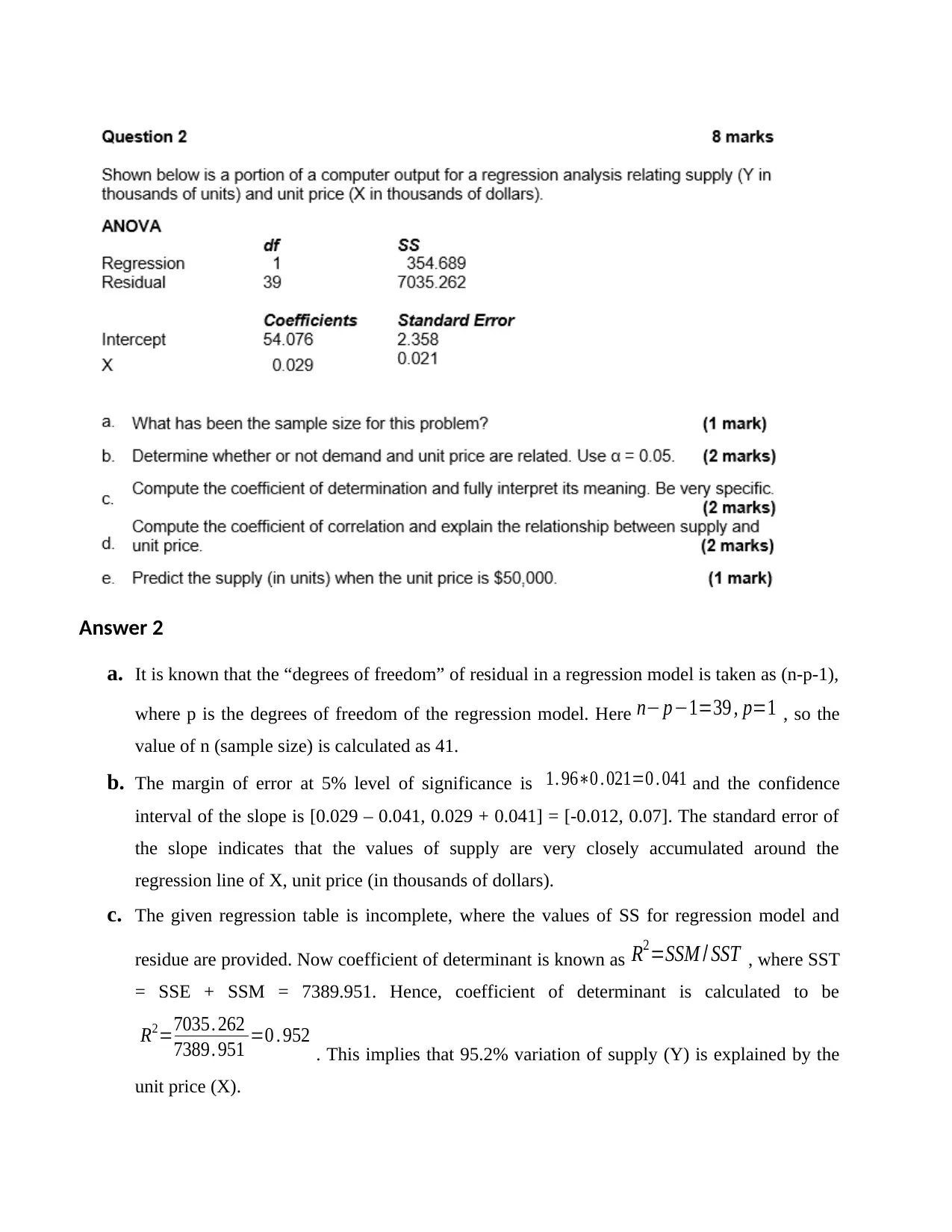
Answer 2
a. It is known that the “degrees of freedom” of residual in a regression model is taken as (n-p-1),
where p is the degrees of freedom of the regression model. Here n− p−1=39 , p=1 , so the
value of n (sample size) is calculated as 41.
b. The margin of error at 5% level of significance is 1. 96∗0 . 021=0 . 041 and the confidence
interval of the slope is [0.029 – 0.041, 0.029 + 0.041] = [-0.012, 0.07]. The standard error of
the slope indicates that the values of supply are very closely accumulated around the
regression line of X, unit price (in thousands of dollars).
c. The given regression table is incomplete, where the values of SS for regression model and
residue are provided. Now coefficient of determinant is known as R2=SSM / SST , where SST
= SSE + SSM = 7389.951. Hence, coefficient of determinant is calculated to be
R2=7035. 262
7389. 951 =0 . 952 . This implies that 95.2% variation of supply (Y) is explained by the
unit price (X).
a. It is known that the “degrees of freedom” of residual in a regression model is taken as (n-p-1),
where p is the degrees of freedom of the regression model. Here n− p−1=39 , p=1 , so the
value of n (sample size) is calculated as 41.
b. The margin of error at 5% level of significance is 1. 96∗0 . 021=0 . 041 and the confidence
interval of the slope is [0.029 – 0.041, 0.029 + 0.041] = [-0.012, 0.07]. The standard error of
the slope indicates that the values of supply are very closely accumulated around the
regression line of X, unit price (in thousands of dollars).
c. The given regression table is incomplete, where the values of SS for regression model and
residue are provided. Now coefficient of determinant is known as R2=SSM / SST , where SST
= SSE + SSM = 7389.951. Hence, coefficient of determinant is calculated to be
R2=7035. 262
7389. 951 =0 . 952 . This implies that 95.2% variation of supply (Y) is explained by the
unit price (X).
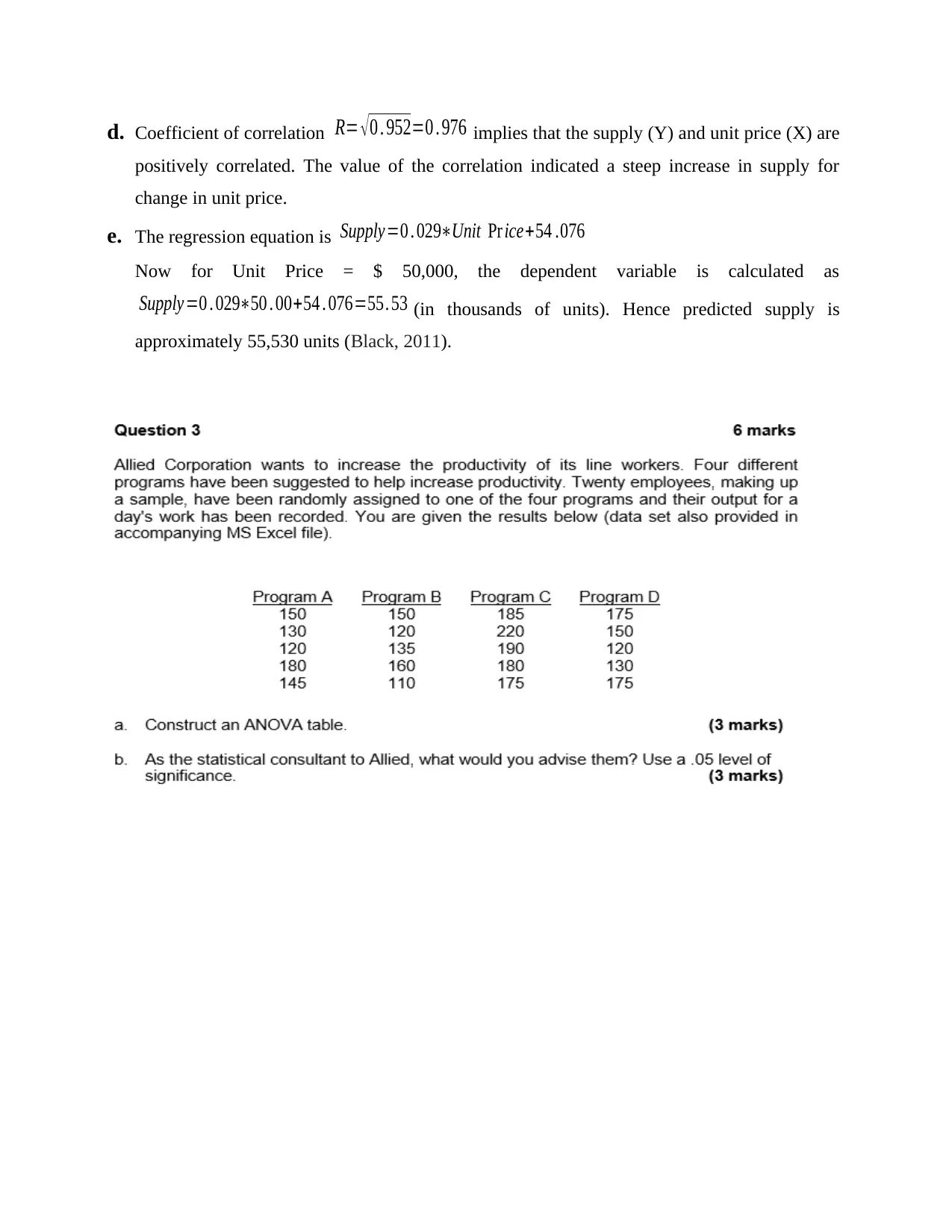
d. Coefficient of correlation R= √ 0 . 952=0 . 976 implies that the supply (Y) and unit price (X) are
positively correlated. The value of the correlation indicated a steep increase in supply for
change in unit price.
e. The regression equation is Supply=0 . 029∗Unit Pr ice+54 .076
Now for Unit Price = $ 50,000, the dependent variable is calculated as
Supply=0 . 029∗50 . 00+54 . 076=55. 53 (in thousands of units). Hence predicted supply is
approximately 55,530 units (Black, 2011).
positively correlated. The value of the correlation indicated a steep increase in supply for
change in unit price.
e. The regression equation is Supply=0 . 029∗Unit Pr ice+54 .076
Now for Unit Price = $ 50,000, the dependent variable is calculated as
Supply=0 . 029∗50 . 00+54 . 076=55. 53 (in thousands of units). Hence predicted supply is
approximately 55,530 units (Black, 2011).
⊘ This is a preview!⊘
Do you want full access?
Subscribe today to unlock all pages.

Trusted by 1+ million students worldwide
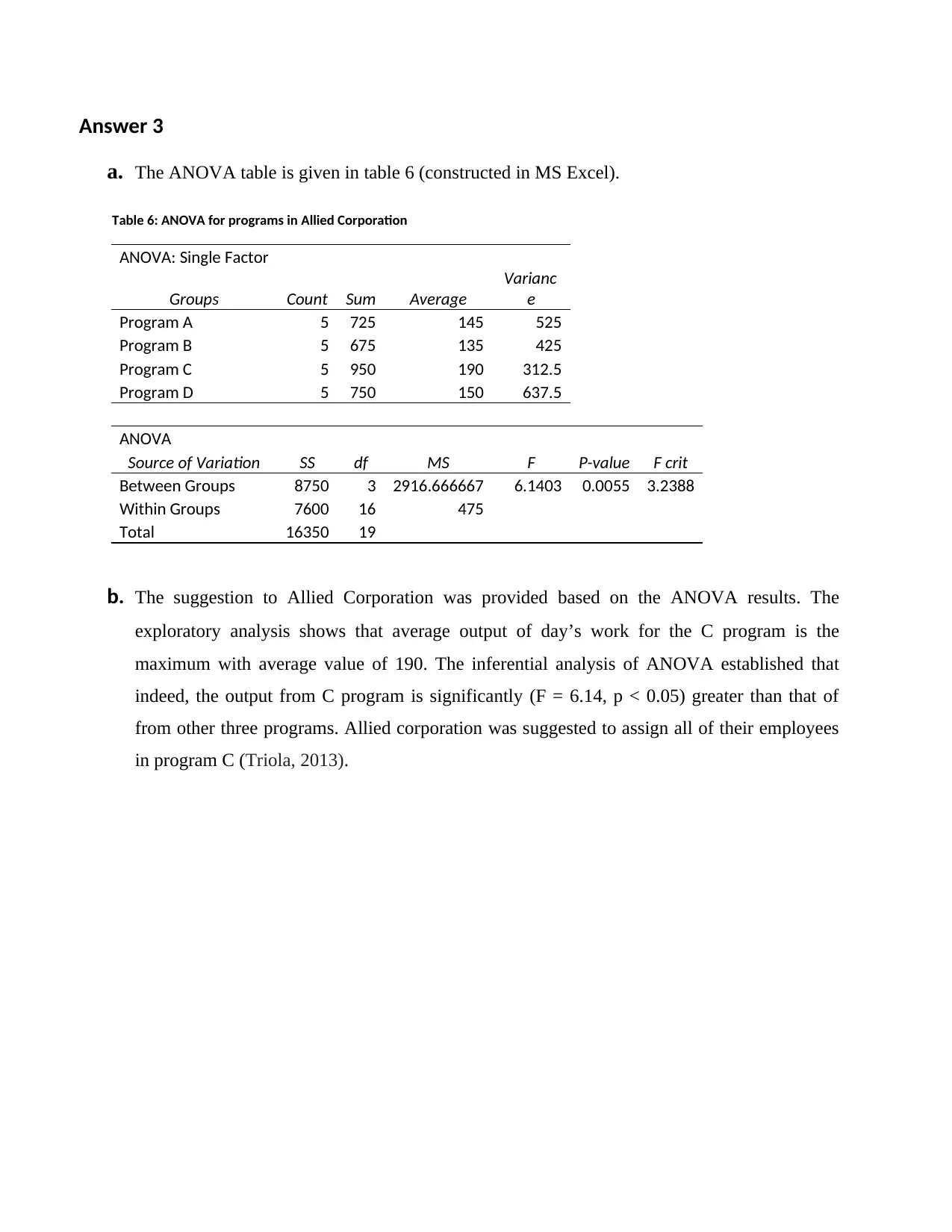
Answer 3
a. The ANOVA table is given in table 6 (constructed in MS Excel).
Table 6: ANOVA for programs in Allied Corporation
ANOVA: Single Factor
Groups Count Sum Average
Varianc
e
Program A 5 725 145 525
Program B 5 675 135 425
Program C 5 950 190 312.5
Program D 5 750 150 637.5
ANOVA
Source of Variation SS df MS F P-value F crit
Between Groups 8750 3 2916.666667 6.1403 0.0055 3.2388
Within Groups 7600 16 475
Total 16350 19
b. The suggestion to Allied Corporation was provided based on the ANOVA results. The
exploratory analysis shows that average output of day’s work for the C program is the
maximum with average value of 190. The inferential analysis of ANOVA established that
indeed, the output from C program is significantly (F = 6.14, p < 0.05) greater than that of
from other three programs. Allied corporation was suggested to assign all of their employees
in program C (Triola, 2013).
a. The ANOVA table is given in table 6 (constructed in MS Excel).
Table 6: ANOVA for programs in Allied Corporation
ANOVA: Single Factor
Groups Count Sum Average
Varianc
e
Program A 5 725 145 525
Program B 5 675 135 425
Program C 5 950 190 312.5
Program D 5 750 150 637.5
ANOVA
Source of Variation SS df MS F P-value F crit
Between Groups 8750 3 2916.666667 6.1403 0.0055 3.2388
Within Groups 7600 16 475
Total 16350 19
b. The suggestion to Allied Corporation was provided based on the ANOVA results. The
exploratory analysis shows that average output of day’s work for the C program is the
maximum with average value of 190. The inferential analysis of ANOVA established that
indeed, the output from C program is significantly (F = 6.14, p < 0.05) greater than that of
from other three programs. Allied corporation was suggested to assign all of their employees
in program C (Triola, 2013).
Paraphrase This Document
Need a fresh take? Get an instant paraphrase of this document with our AI Paraphraser
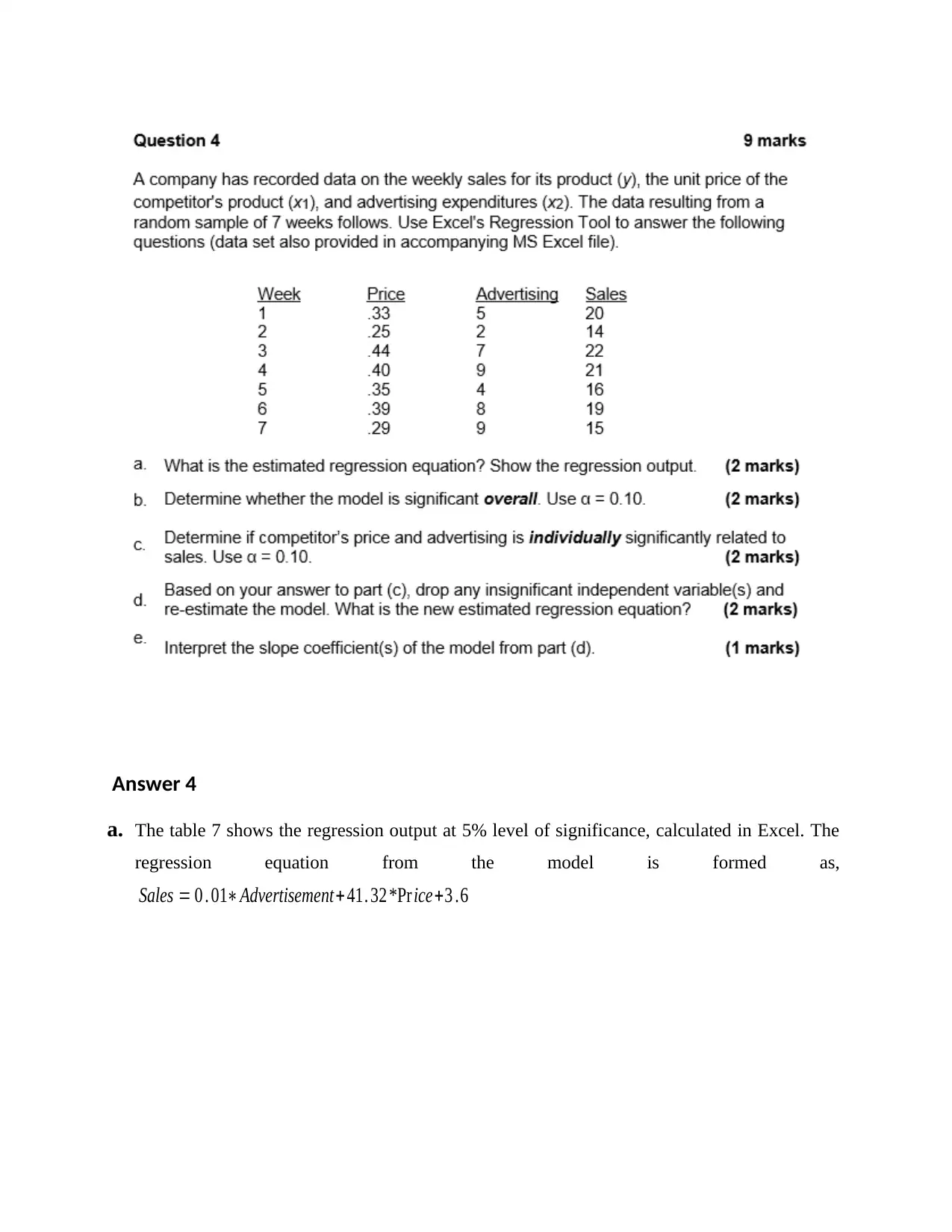
Answer 4
a. The table 7 shows the regression output at 5% level of significance, calculated in Excel. The
regression equation from the model is formed as,
Sales = 0 . 01∗Advertisement+ 41. 32 *Pr ice+3 .6
a. The table 7 shows the regression output at 5% level of significance, calculated in Excel. The
regression equation from the model is formed as,
Sales = 0 . 01∗Advertisement+ 41. 32 *Pr ice+3 .6
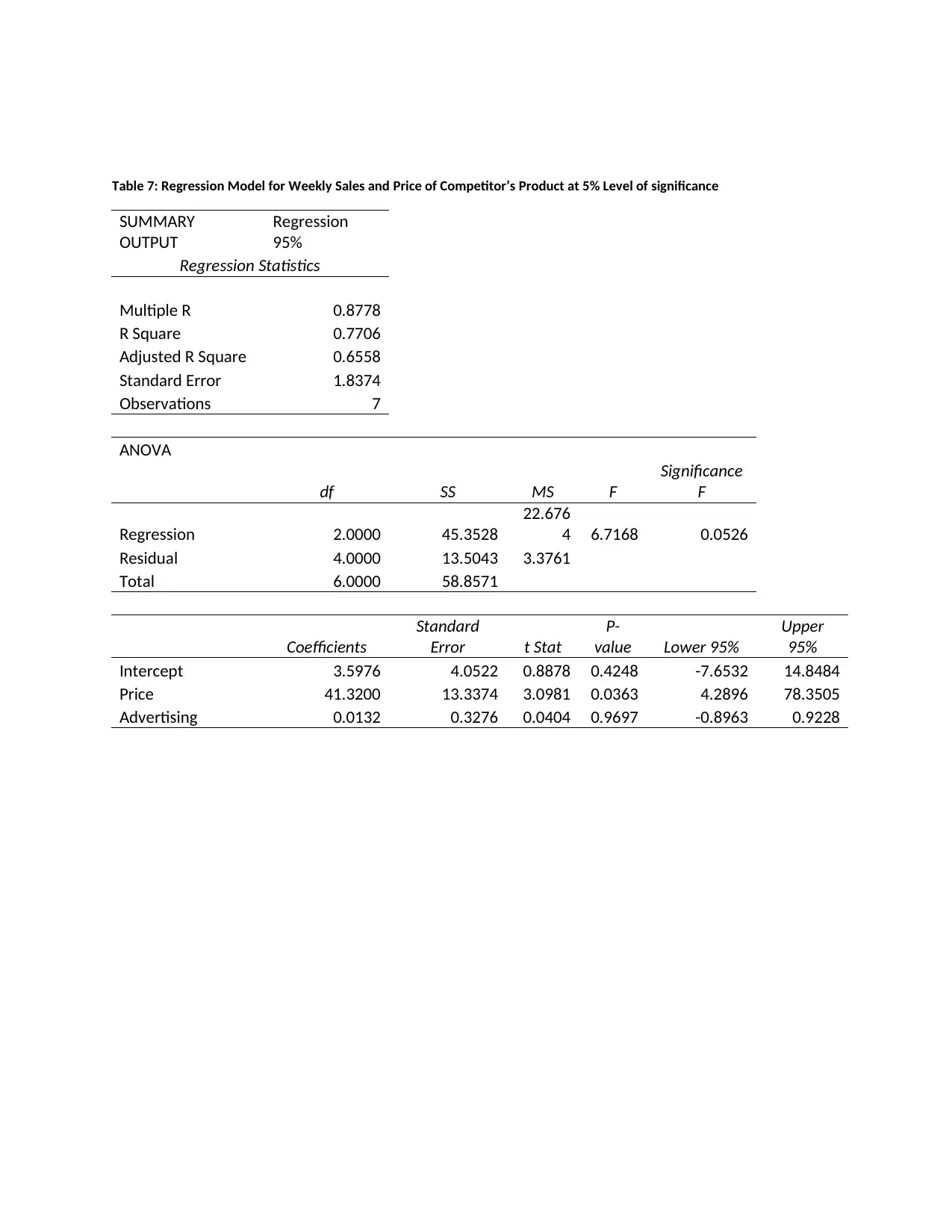
Table 7: Regression Model for Weekly Sales and Price of Competitor’s Product at 5% Level of significance
SUMMARY
OUTPUT
Regression
95%
Regression Statistics
Multiple R 0.8778
R Square 0.7706
Adjusted R Square 0.6558
Standard Error 1.8374
Observations 7
ANOVA
df SS MS F
Significance
F
Regression 2.0000 45.3528
22.676
4 6.7168 0.0526
Residual 4.0000 13.5043 3.3761
Total 6.0000 58.8571
Coefficients
Standard
Error t Stat
P-
value Lower 95%
Upper
95%
Intercept 3.5976 4.0522 0.8878 0.4248 -7.6532 14.8484
Price 41.3200 13.3374 3.0981 0.0363 4.2896 78.3505
Advertising 0.0132 0.3276 0.0404 0.9697 -0.8963 0.9228
SUMMARY
OUTPUT
Regression
95%
Regression Statistics
Multiple R 0.8778
R Square 0.7706
Adjusted R Square 0.6558
Standard Error 1.8374
Observations 7
ANOVA
df SS MS F
Significance
F
Regression 2.0000 45.3528
22.676
4 6.7168 0.0526
Residual 4.0000 13.5043 3.3761
Total 6.0000 58.8571
Coefficients
Standard
Error t Stat
P-
value Lower 95%
Upper
95%
Intercept 3.5976 4.0522 0.8878 0.4248 -7.6532 14.8484
Price 41.3200 13.3374 3.0981 0.0363 4.2896 78.3505
Advertising 0.0132 0.3276 0.0404 0.9697 -0.8963 0.9228
⊘ This is a preview!⊘
Do you want full access?
Subscribe today to unlock all pages.

Trusted by 1+ million students worldwide
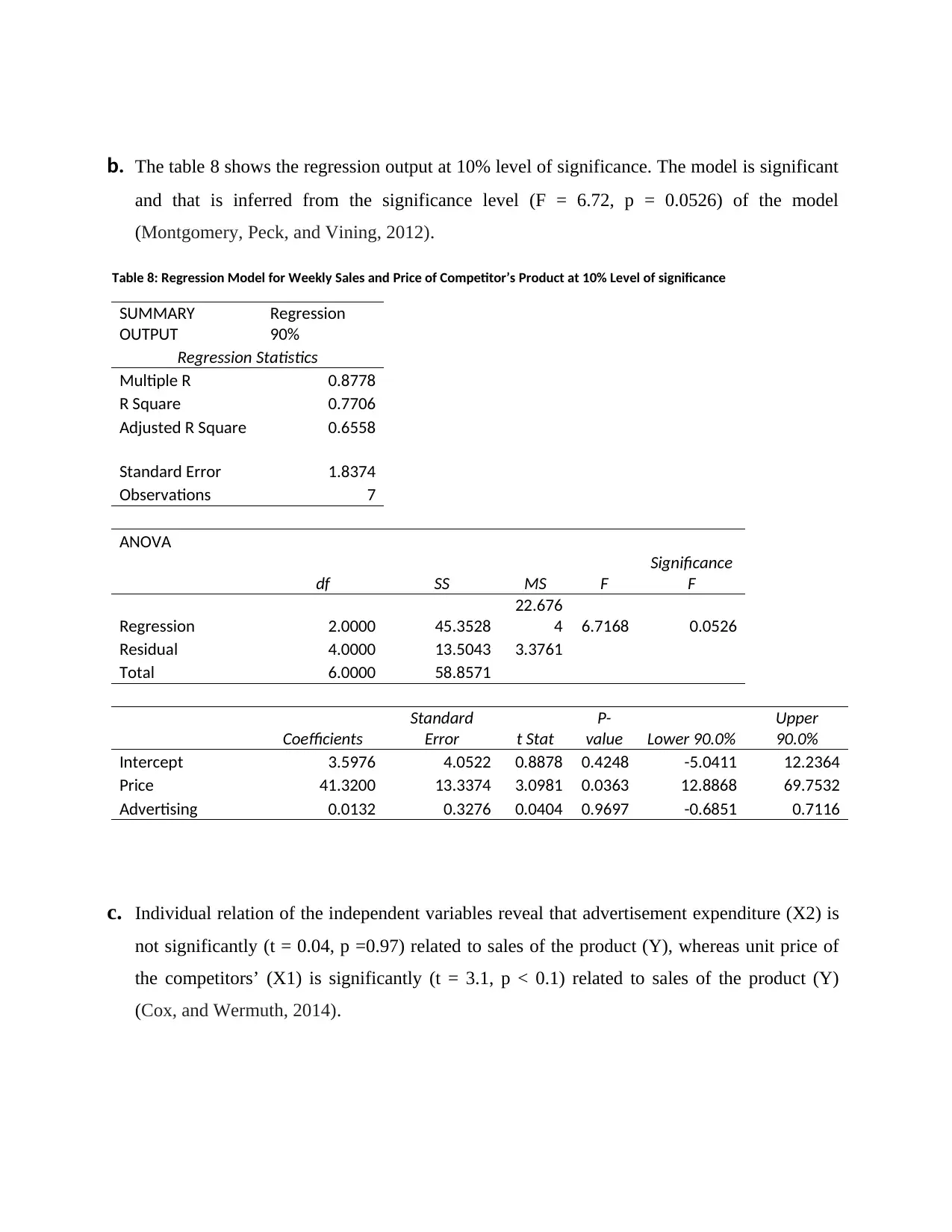
b. The table 8 shows the regression output at 10% level of significance. The model is significant
and that is inferred from the significance level (F = 6.72, p = 0.0526) of the model
(Montgomery, Peck, and Vining, 2012).
Table 8: Regression Model for Weekly Sales and Price of Competitor’s Product at 10% Level of significance
SUMMARY
OUTPUT
Regression
90%
Regression Statistics
Multiple R 0.8778
R Square 0.7706
Adjusted R Square 0.6558
Standard Error 1.8374
Observations 7
ANOVA
df SS MS F
Significance
F
Regression 2.0000 45.3528
22.676
4 6.7168 0.0526
Residual 4.0000 13.5043 3.3761
Total 6.0000 58.8571
Coefficients
Standard
Error t Stat
P-
value Lower 90.0%
Upper
90.0%
Intercept 3.5976 4.0522 0.8878 0.4248 -5.0411 12.2364
Price 41.3200 13.3374 3.0981 0.0363 12.8868 69.7532
Advertising 0.0132 0.3276 0.0404 0.9697 -0.6851 0.7116
c. Individual relation of the independent variables reveal that advertisement expenditure (X2) is
not significantly (t = 0.04, p =0.97) related to sales of the product (Y), whereas unit price of
the competitors’ (X1) is significantly (t = 3.1, p < 0.1) related to sales of the product (Y)
(Cox, and Wermuth, 2014).
and that is inferred from the significance level (F = 6.72, p = 0.0526) of the model
(Montgomery, Peck, and Vining, 2012).
Table 8: Regression Model for Weekly Sales and Price of Competitor’s Product at 10% Level of significance
SUMMARY
OUTPUT
Regression
90%
Regression Statistics
Multiple R 0.8778
R Square 0.7706
Adjusted R Square 0.6558
Standard Error 1.8374
Observations 7
ANOVA
df SS MS F
Significance
F
Regression 2.0000 45.3528
22.676
4 6.7168 0.0526
Residual 4.0000 13.5043 3.3761
Total 6.0000 58.8571
Coefficients
Standard
Error t Stat
P-
value Lower 90.0%
Upper
90.0%
Intercept 3.5976 4.0522 0.8878 0.4248 -5.0411 12.2364
Price 41.3200 13.3374 3.0981 0.0363 12.8868 69.7532
Advertising 0.0132 0.3276 0.0404 0.9697 -0.6851 0.7116
c. Individual relation of the independent variables reveal that advertisement expenditure (X2) is
not significantly (t = 0.04, p =0.97) related to sales of the product (Y), whereas unit price of
the competitors’ (X1) is significantly (t = 3.1, p < 0.1) related to sales of the product (Y)
(Cox, and Wermuth, 2014).
Paraphrase This Document
Need a fresh take? Get an instant paraphrase of this document with our AI Paraphraser
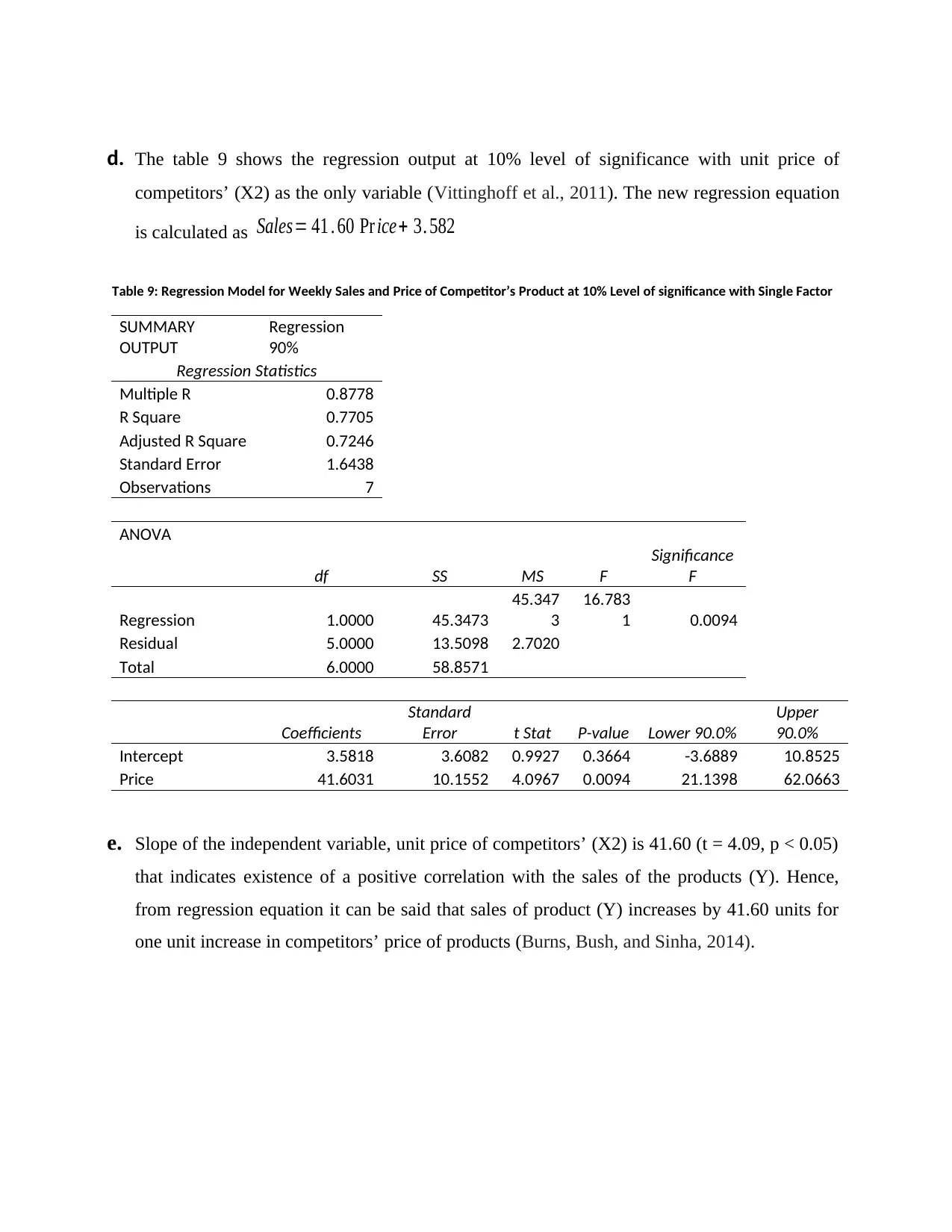
d. The table 9 shows the regression output at 10% level of significance with unit price of
competitors’ (X2) as the only variable (Vittinghoff et al., 2011). The new regression equation
is calculated as Sales= 41 . 60 Pr ice+ 3. 582
Table 9: Regression Model for Weekly Sales and Price of Competitor’s Product at 10% Level of significance with Single Factor
SUMMARY
OUTPUT
Regression
90%
Regression Statistics
Multiple R 0.8778
R Square 0.7705
Adjusted R Square 0.7246
Standard Error 1.6438
Observations 7
ANOVA
df SS MS F
Significance
F
Regression 1.0000 45.3473
45.347
3
16.783
1 0.0094
Residual 5.0000 13.5098 2.7020
Total 6.0000 58.8571
Coefficients
Standard
Error t Stat P-value Lower 90.0%
Upper
90.0%
Intercept 3.5818 3.6082 0.9927 0.3664 -3.6889 10.8525
Price 41.6031 10.1552 4.0967 0.0094 21.1398 62.0663
e. Slope of the independent variable, unit price of competitors’ (X2) is 41.60 (t = 4.09, p < 0.05)
that indicates existence of a positive correlation with the sales of the products (Y). Hence,
from regression equation it can be said that sales of product (Y) increases by 41.60 units for
one unit increase in competitors’ price of products (Burns, Bush, and Sinha, 2014).
competitors’ (X2) as the only variable (Vittinghoff et al., 2011). The new regression equation
is calculated as Sales= 41 . 60 Pr ice+ 3. 582
Table 9: Regression Model for Weekly Sales and Price of Competitor’s Product at 10% Level of significance with Single Factor
SUMMARY
OUTPUT
Regression
90%
Regression Statistics
Multiple R 0.8778
R Square 0.7705
Adjusted R Square 0.7246
Standard Error 1.6438
Observations 7
ANOVA
df SS MS F
Significance
F
Regression 1.0000 45.3473
45.347
3
16.783
1 0.0094
Residual 5.0000 13.5098 2.7020
Total 6.0000 58.8571
Coefficients
Standard
Error t Stat P-value Lower 90.0%
Upper
90.0%
Intercept 3.5818 3.6082 0.9927 0.3664 -3.6889 10.8525
Price 41.6031 10.1552 4.0967 0.0094 21.1398 62.0663
e. Slope of the independent variable, unit price of competitors’ (X2) is 41.60 (t = 4.09, p < 0.05)
that indicates existence of a positive correlation with the sales of the products (Y). Hence,
from regression equation it can be said that sales of product (Y) increases by 41.60 units for
one unit increase in competitors’ price of products (Burns, Bush, and Sinha, 2014).
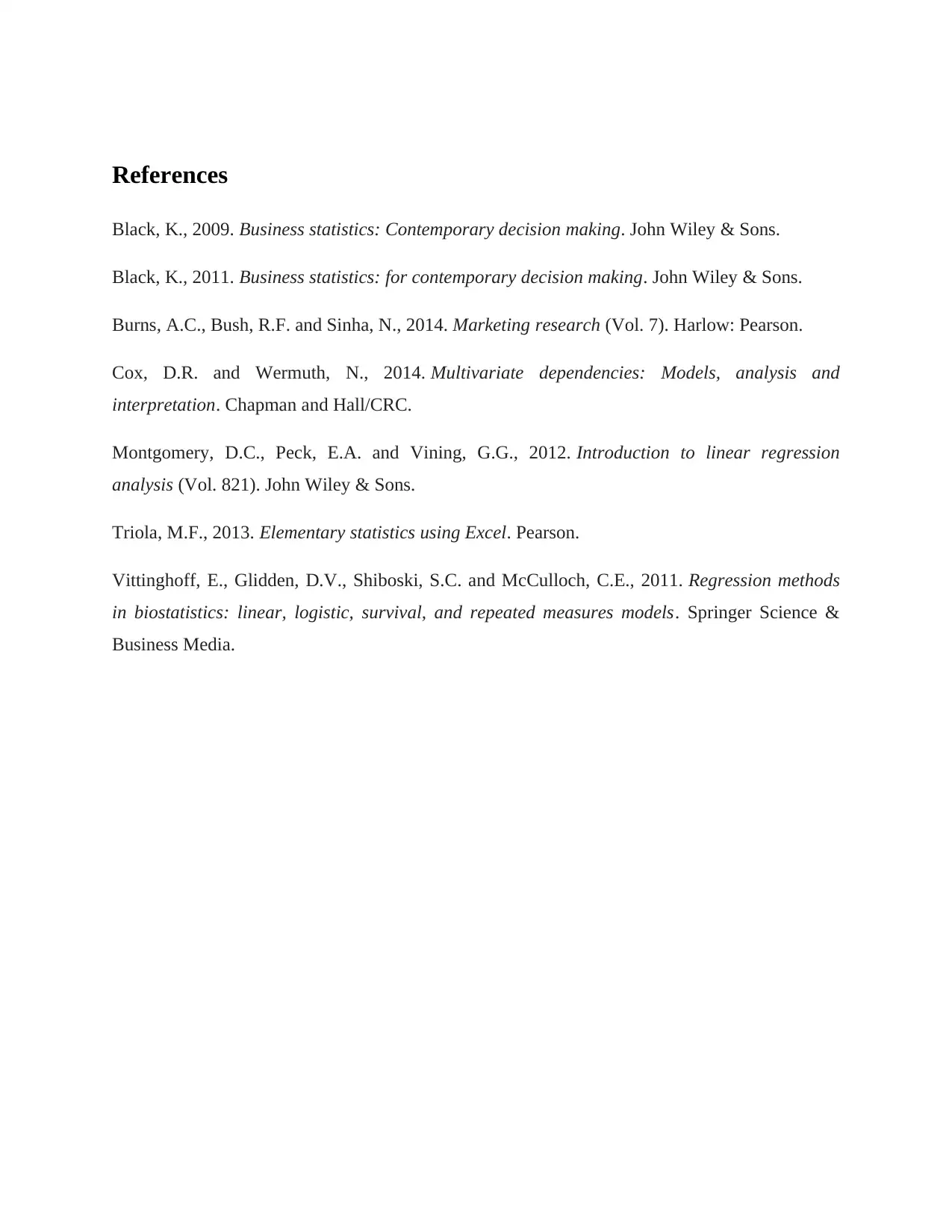
References
Black, K., 2009. Business statistics: Contemporary decision making. John Wiley & Sons.
Black, K., 2011. Business statistics: for contemporary decision making. John Wiley & Sons.
Burns, A.C., Bush, R.F. and Sinha, N., 2014. Marketing research (Vol. 7). Harlow: Pearson.
Cox, D.R. and Wermuth, N., 2014. Multivariate dependencies: Models, analysis and
interpretation. Chapman and Hall/CRC.
Montgomery, D.C., Peck, E.A. and Vining, G.G., 2012. Introduction to linear regression
analysis (Vol. 821). John Wiley & Sons.
Triola, M.F., 2013. Elementary statistics using Excel. Pearson.
Vittinghoff, E., Glidden, D.V., Shiboski, S.C. and McCulloch, C.E., 2011. Regression methods
in biostatistics: linear, logistic, survival, and repeated measures models. Springer Science &
Business Media.
Black, K., 2009. Business statistics: Contemporary decision making. John Wiley & Sons.
Black, K., 2011. Business statistics: for contemporary decision making. John Wiley & Sons.
Burns, A.C., Bush, R.F. and Sinha, N., 2014. Marketing research (Vol. 7). Harlow: Pearson.
Cox, D.R. and Wermuth, N., 2014. Multivariate dependencies: Models, analysis and
interpretation. Chapman and Hall/CRC.
Montgomery, D.C., Peck, E.A. and Vining, G.G., 2012. Introduction to linear regression
analysis (Vol. 821). John Wiley & Sons.
Triola, M.F., 2013. Elementary statistics using Excel. Pearson.
Vittinghoff, E., Glidden, D.V., Shiboski, S.C. and McCulloch, C.E., 2011. Regression methods
in biostatistics: linear, logistic, survival, and repeated measures models. Springer Science &
Business Media.
⊘ This is a preview!⊘
Do you want full access?
Subscribe today to unlock all pages.

Trusted by 1+ million students worldwide
1 out of 12